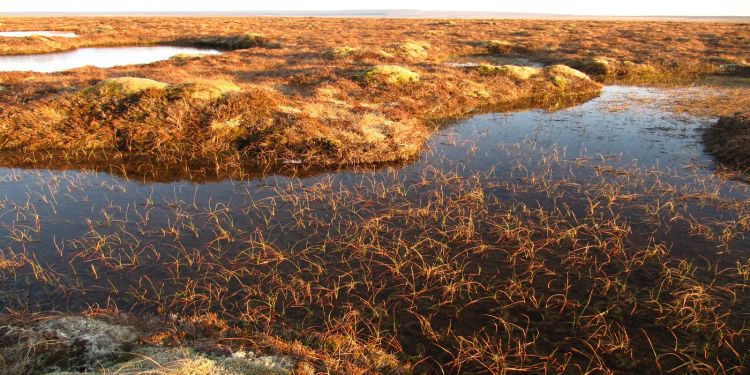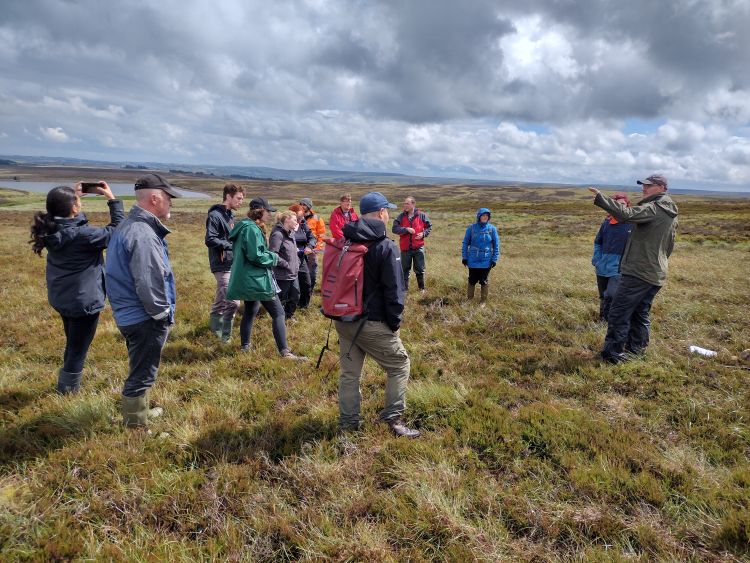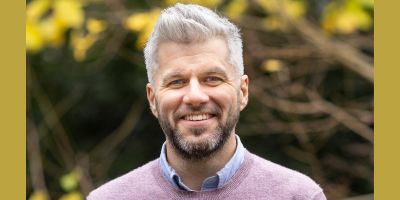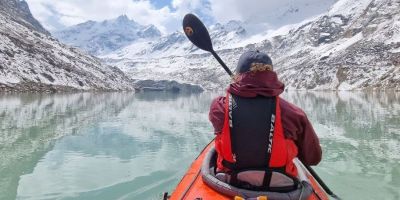Restoring and protecting essential peatlands

At the University of Leeds, academics and practitioners are working towards peatland restoration in the UK, EU and beyond. This World Soil Day, we explore their latest work.
Peat is a type of soil that is formed from partially decayed organic matter. As the National Trust explains, “Peat is vital to the environment, as it helps maintain four areas called ‘ecosystem services’:
- Carbon store – peat holds more carbon than the combined forests of Britain, France and Germany.
- For wildlife – many scarce species inhabit peatlands.
- For water management – peat holds up to 20 times its own weight in water.
- For archaeology – peat preserves a record of past vegetation, landscapes and people.”
This World Soil Day, we highlight the essential work that happens through the University of Leeds to protect and restore this vital part of our earth.
Wetlands and peatlands in Europe
WaterLANDS is an EU-funded project that aims to restore wetland sites, including three peatland sites, throughout Europe.
The project delivers and supports wetland restoration at six Action Sites in Estonia, Ireland, Italy, The Netherlands, Bulgaria and the UK.
In the UK, the Yorkshire Integrated Catchment Solutions Programme (iCASP) at the University of Leeds is supporting the Great North Bog coalition. They aim to restore all remaining degraded blanket peatlands across the North of England.
ICASP's team collaborates with practitioners across the six WaterLANDS Action Sites, sharing ideas and knowledge about their approaches to restore peatlands.
Through water@leeds, the group hosts one of 15 knowledge sites that uses experiences of working with wetlands to inform future restoration within the WaterLANDS project and beyond.
Citizen science
As well as collaborating with other institutions and experts, the restoration team engage local communities in their work in the peatlands.
Dr Antony Blundell recently led citizen science workshops in Northumberland, Cumbria and West Yorkshire.
With around 80 members of local communities and organisations, Dr Blundell discussed peatland’s history and how it’s managed.
The participants took part in peat coring activities, in which they took samples of peat and compared the signs of pre- and post-industrial peat.
The workshops helped the community members understand the history and importance of peatlands.
They empowered the public to collect peatland data, which will help to build a network of information about the health of our peatlands and how they can be managed.
The workshops were hosted by the Northumberland Peat Partnership, William Morris-Bell, the National Trust, RSPB Geltsdale, the North Pennine Area of Natural Beauty (AONB) Partnership and Yorkshire Water.
Read iCASP’s blog post about their experience at Whitelee Moor in Northumberland.
Peatland-inspired artwork
It’s not only about representing the peatlands in data. Through WaterLANDS, iCASP has employed two artists to share the journey of peatland restoration at the Great North Bog.
The artists in residence are Laura Harrington and Feral Practice (Fiona MacDonald).
Over 4 years, the artists will engage with communities, scientists, peatland restoration practitioners and others involved with peatlands. They will produce artworks guided by their experiences, with an aim that more people become inspired by and involved with Peatlands and the work needed to restore them.
Laura and Fiona take part in engagement workshops hosted by WaterLANDS, such as the recent tour of Fleet Moss, led by Jenny Sharman from Yorkshire Peat Partnership.
Sign up to the WaterLANDS newsletter to find out more about the their UK work.
Another artistic project focussing on peat has been commissioned for the University of Leeds’ campus.
The sculpture, to be based at stage@leeds on campus, will be a collaboration between Katie and community participants from Mafwa Theatre. Mafwa Theatre is a community company working with refugees, asylum seekers and settled communities in Leeds.
Katie led the participants to explore Askham Bog and discover what inspires them about the environment.
The day included a pond dipping workshop by Professor Lee Brown from the School of Geography. He helped the participants identify wildlife species and talked about the importance of peatlands.
Katie is now creating a large ‘living wall’ that centres on their experiences.
These aspects of the project show how art and community engagement can be expansive for and cohesive with environmental research.
International peat projects
As well as in the UK and Europe, researchers at the University of Leeds work on a range of research projects that seek to restore peatlands in the Congo Basin.
The Congo Basin is the world's largest tropical peatland. CongoPeat is a project is led by Professor Simon Lewis and involves Professor Andy Baird, Dr Paul Morris and Dr Greta Dargie from the School of Geography.
They work alongside experts from the Universities of Leicester, Exeter, Kisangani (Democratic Republic of Congo), Marien Ngouabi (Republic of Congo), St Andrews, Edinburgh and Nottingham as well as the United Nations and the Met Office.
CongoPeat is funded by the UK’s Natural Environment Research Council (NERC).
Last year, the team mapped the peatlands in the central Congo Basin and found them to be 15% bigger than previously expected.
They found that the central Congo Basin is home to 36% of the world’s tropical peatland area and stores 28% of the world’s tropical peat carbon, but only 8% of the carbon was within nationally protected areas.
In a later study, researchers from the institutions describe the vulnerability of the carbon stocks within the central Congo Basin.
As well as the threat of the peatlands getting drier from climate change, the region is subject to additional pressures that damage the fragile peatland ecosystem, from draining the peatland for industrial-scale agriculture, logging and oil exploration.
Earlier this year, Professor Lewis was elected a Fellow of the Royal Society, due to his research into the Congo peatlands. He said that it was thanks to “two decades of teamwork”.
Calls for research and investment
Professor Lewis is part of a group of scientists who launched the Congo Basin Science Initiative at the Summit of the Three Basins this year, to drive investment in Congo Basin science and scientists.
He addressed the Summit in Brazzaville, Republic of the Congo, which is a major government-led meeting for tropical forest-rich countries to cooperate.
He also met with the Environment Ministers of the Republic of the Congo and the Democratic Republic of the Congo.
Professor Lewis and Dr Dargie of CongoPeat have recently been awarded funding from the United Nations Environment Program.
This will support them to produce new maps of the central Congo peatlands, build a research network in the region and assist in capacity building over the next four years.





